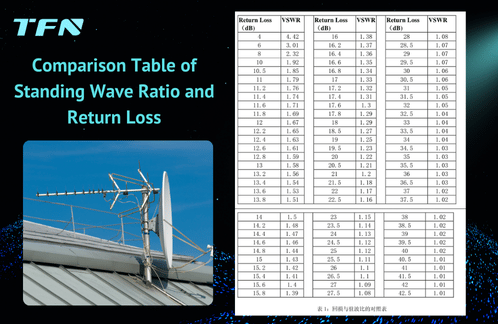Essential for antenna and feeder system maintenance: Daily inspection process of TFN tester
1. Why do we need an cable and antenna analyzer?
The antenna and feeder system is a core component of communication base stations, radio and television, and its performance directly affects the quality of signal transmission. Problems such as abnormal standing wave ratio, excessive return loss, or excessive cable loss may cause signal attenuation or even equipment damage. The TFN cable and antenna analyzer has become an indispensable tool for daily maintenance due to its high precision, multi-function and portability. It can quickly complete calibration, standing wave ratio testing, return loss analysis, and cable loss measurement, helping engineers to locate problems efficiently.
2. Core operation process of the cable and antenna analyzer
2.1 Calibration: The first step to ensure test accuracy
The TFN cable and antenna analyzer uses the open-short-load (OSL) calibration method. The following steps must be completed before testing:
2.1.1 Set frequency parameters: Enter the calibration mode, enter the start and end frequencies (such as 25MHz-4000MHz), and select the number of measurement points (137/275/551/1103).
2.1.2 Connect the calibration parts: Connect the open circuit, short circuit, and load calibration parts to the RF port (N-type female) in turn.
2.1.3 Perform calibration: Click the corresponding load button, and the system automatically completes the calibration and displays the curve. After the calibration is completed, "Calibration is valid" is displayed in the lower left corner of the interface.
2.1.4. Save calibration data: Save the calibration results through the file menu to facilitate subsequent repeated calls and reduce repeated operation time.
Note: Recalibration is required after temperature changes or frequency range adjustment to ensure data reliability.
2.2 Standing wave ratio test: locate impedance matching problems
The standing wave ratio (VSWR) reflects the impedance matching status of the antenna feeder system. The TFN cable antenna analyzer supports two test modes:
- Frequency standing wave ratio: suitable for full-band analysis.
- DTF standing wave ratio: used to locate the distance of the fault point.
Operation steps:
2.2.1 Enter "Measurement Mode" and select "Frequency Standing Wave Ratio" or "Fault Distance Standing Wave Ratio".
2.2.2 Set parameters: input frequency range, cable propagation velocity (such as 0.85) and window function (rectangular window/Hamming window, etc.).
2.2.3 Start test: click "single measurement" or "continuous measurement" to display the VSWR curve in real time.
2.2.4 Data analysis: use the marker line to locate the peak value, set the threshold value through the limit line (such as VSWR≤1.5), and the exceeding area will be automatically marked in red.
Efficient skills: use the hard keyboard to quickly adjust parameters, and save images or CSV data with one click to facilitate subsequent report generation.
2.3 Return loss test: evaluate signal reflection strength
Return loss and standing wave ratio are related parameters. The TFN cable antenna analyzer supports two modes:
- Frequency return loss: analyze the reflection performance of the entire frequency band.
- DTF return loss: accurately locate the reflection point.
Operation process:
2.3.1 Select "Frequency Return Loss" or "Fault Distance Return Loss" on the main interface.
2.3.2 Synchronous parameter setting: The frequency range must be consistent with the calibration parameters, and the cable parameters must be accurately entered (propagation speed, loss value).
2.3.3 Execute the test: Use the "Start" button to quickly measure, and the screen will display the return loss curve and key values (such as -30dB).
2.3.4 Optimization analysis: Turn on the data smoothing function to eliminate noise interference; compare historical data (memory function) to quickly determine performance changes.

2.4 Cable loss test: verify transmission efficiency
Cable loss directly affects the signal transmission distance. The TFN cable antenna analyzer provides two methods:
- Manual parameter input: When the cable type is known, directly enter the propagation velocity and loss value.
- Automatic calibration: Through the "Cable Calibration" tool, connect a cable of known length (0.5-10 meters), and the system automatically calculates the parameters.
Test steps:
2.4.1 Select the "Cable Loss" measurement mode and set the frequency range (such as 25MHz-4000MHz).
2.4.2 Enter the cable parameters or perform calibration (connect an open circuit load).
2.4.3 Start the measurement, and the result will display the loss curve in dB/meter, supporting Y-axis scale adjustment (default 0-30dB).
2.4.4 Export data to the PC management software to generate a loss trend chart to assist in deciding whether to replace the cable.
3. Practical process: Efficiently complete antenna and feeder system detection
Combined with the functions of TFN cable and antenna analyzer, daily maintenance can be carried out in the following steps to achieve efficient and coherent operation:
Power-on preparation: Check the battery power and connect the adapter to ensure stable power supply.
One-key calibration: Call historical calibration data or perform OSL calibration (takes about 3 minutes).
Parameter preset: Use PC software to pre-store common frequencies and cable types to shorten on-site setting time.
Batch test: Complete the standing wave ratio, return loss, and cable loss tests in sequence, and reduce the interval through the "continuous measurement" mode.
Data management: Export CSV and image files through the USB interface, and generate PDF reports in combination with PC software.
Advantage Summary:
- Touch screen + hard keyboard dual operation mode to adapt to different environmental requirements.
- 8 hours of battery life + fast charging to meet all-weather operations.
- 2000 storage capacity, support historical data comparison and analysis.
4. Conclusion
TFN cable and antenna analyzer standardizes the complex antenna and feeder detection process through calibration, parameterized settings and multi-functional test modules, greatly improving maintenance efficiency. Whether it is base station inspection or troubleshooting, the rational use of its fast measurement, data storage and analysis functions can significantly reduce operation and maintenance costs and ensure the stable operation of the communication system.
